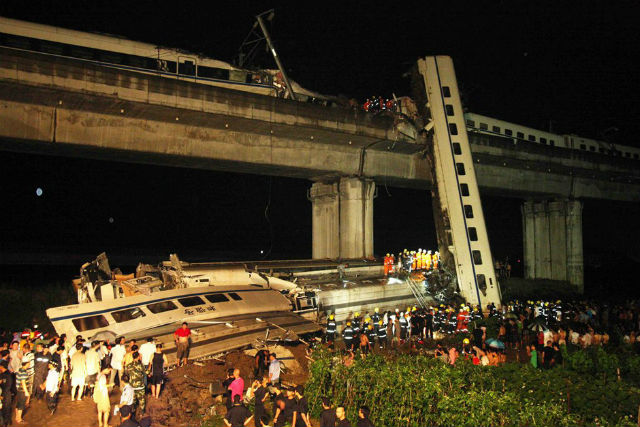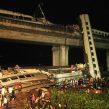
Wenzhou Crash Shows the Dangers of China’s Nuclear Power Ambitions
Publication: China Brief Volume: 11 Issue: 14
By:

A high-speed train crash near Wenzhou in the coastal Chinese province of Zhejiang took the lives of at least 39 people on July 23 and has raised equal measures of fear, anger and astonishment across the country. Preliminary reports indicate that a bullet train running from Hangzhou to Fuzhou had been struck by lightning, causing it to break down on the tracks. Shortly afterwards another locomotive heading from Beijing to Fuzhou careened into the stalled train, derailing six cars and pushing four of them entirely off the viaduct (New York Times, July 24; 21st Century Herald, July 27). In addition to the fatalities, at least 210 were injured in what is now the highest-profile setback for China’s ambitious rail program. While Beijing has moved quickly to control the flow of information (albeit not successfully) surrounding the disaster and disclosed the foreign origin of its bullet train technologies, the Chinese public and the broader international community are unlikely to be satisfied by such dismissals (Caijing, July 24). The accident is a “canary in the coal mine”, as it were, for a much larger structural challenge facing China. The breadth of Chinese ambitions to indigenize foreign technologies and scale them for mass deployment has simply outpaced its ability to plan, operate and staff these complex undertakings in a safe and sustainable manner. This is true in the case of high-speed rail, and it threatens to become the overarching storyline for the country’s nuclear energy program. The tragedy on the tracks in Wenzhou delivers lessons that Beijing would be wise to heed, not only for the management of its rail networks but also for the more critical issue of its 2020 nuclear energy goals.
The Fall of Ministry of Railways (MOR) in China
The crash on July 23 is not the only incident to have blemished the Chinese high-speed rail program. In February of this year, former Railways Minister Liu Zhijun was removed from his post for “severe” disciplinary violations in conjunction with an allegedly ongoing corruption probe that exposed $152 million in bribes associated with railway projects (Lianhe Zaobao, Feburary 14). Meanwhile, the deputy chief of the MOR transportation bureau, Su Shunhu, is also under investigation for bribery claims (Bloomberg, July 25; Jinghua Daily, July 27). Zhang Shuguang, another Railways Ministry official, has already been removed for similar improprieties (Jinghua Daily, March 2). The new Minister of Railways, Sheng Guangzu, has since announced that the top speed for Chinese trains will be reduced from 350 km/h to 300 km/h, largely in response to concerns that the seemingly endemic graft and corruption associated with the construction of new rail lines may have compromised their safety (Caixun, April 13; Financial Times, April 14).
The Wenzhou collision is not the fault of defective train cars, shoddy tracks or any other physical deficiency. According to An Lusheng, the newly appointed director general of Shanghai Railway Bureau, an ill designed signaling system coupled with inexperienced and undertrained railway staff caused the accident (Xinhua, July 28). Not surprisingly, the accident probe’s preliminary result further shifts public attention onto China’s failure to adequately administer and operate its rail network. The crash indicates a broader deficiency in management capacity. Unfortunately, China’s immediate reaction simply to fire three railway chiefs the day following the crash is a symptom of its lack of accountability more than a cure for it (People’s Daily, July 24). People’s Net recently ran an editorial titled “No Development without Safety” that brought attention to a lack of any emergency plans for lightning-debilitated trains despite the fact that the MOR previously acknowledged the vulnerability of the rail system to such lightning strikes. The problems are clearly greater than any three individuals, and, in reacting with such symbolic gestures, Beijing risks obfuscating the need for a rigorous and comprehensive review of its approach to high-speed rail and other megaprojects.
The model that China has thus far employed in its high-speed rail program is predicated upon acquiring foreign technology through its competitive bidding process. China’s uniquely large market has allowed the MOR—in conjunction with state-owned corporations such as China North Car and China South Locomotive & Rolling Stock Co., Ltd.—to attract advanced rail systems and equipment from abroad at attractive prices. Four foreign companies—Siemens of Germany, Alstom of France, Bombardier of Canada and Kawasaki of Japan—have been involved heavily in the development of the Chinese high-speed system since 2004. In its haste to build a stronger domestic industry and ensure that rail development would not benefit only foreign companies, the country has undertaken a concerted effort to indigenize these technologies at a breakneck pace, adding marginal improvements and enhancements along the way (Xinhua, March 4 2010). All successful bidders, for example, had to assemble units exclusively through local joint ventures (JV) or cooperation with Chinese manufacturers (People’s Daily, July 11).
Regardless of the merits or legality of China’s highly strategic foreign contracts and technology acquisition, a daunting question remains: how much new high-speed rail technology can the country rapidly absorb and still operate safely with a properly-trained workforce? Before the commissioning of the Beijing-Tianjin Intercity Railway in August 2008, a German expert required drivers of China’s first 350 km/h bullet train receive two to three months’ intensive training. Nevertheless, to save time ahead of the field test, these drivers were ordered to shorten the duration of their training to only 10 days (People’s Daily, December 14, 2010). It is here that China’s reach has exceeded its grasp and the consequences just are beginning to show. Advanced technology still requires training and occasionally simple human error coupled with hardware failure can nullify even the most redundant safety systems.
The Implications for China’s Nuclear Leap Forward
Personnel, training and safeguards are where the comparison to China’s nuclear program is most pertinent. Prior to the Fukushima Daiichi disaster on March 11, the installed operational nuclear capacity in China was only 10.8 gigawatts (GW). Beijing also had been steadily increasing its 2020 nuclear target, as ambitious industry groups and pliant politicians allowed the goals to creep from a 2007 governmental plan at 40 GW of installed operational capacity to suggestions of 70, 86 or even greater than 100 GW [1]. In retrospect, the unfolding of a great nuclear leap forward in China seemed to be inevitable. The severity of Fukushima accident fortunately prompted Beijing to halt approvals of new nuclear power plants pending changes to safety standards. This move signaled a shift toward caution from a country that is embarking on the world’s biggest nuclear expansion program but where public fears of nuclear contamination are growing. However, a lack of check and balance in China’s political system has gradually shifted the debate to the advantage of nuclear power advocates, which can be demonstrated best by the Ministry of Science and Technology’s ambitious plan to indigenize Westinghouse AP1000 and scale its capacity from 1.0 GW to 1.4 GW as early as 2015 [2]. In comparison, a nuclear developer in an OECD country might not be able to finish just the permitting process over a similar length of time.
China’s strategy for nuclear energy development and deployment also closely mirrors that for its high-speed rail program. Technology transfer is similarly front and center, with a menu of commercial scale reactors being built through a typical market access in exchange of foreign technology approach to showcase the latest Generation II and Generation III designs from abroad. M310 (France), CANDU 6 (Canada), AES-91 (Russia), Westinghouse AP1000 (U.S) and EPR (France) are all examples of imported technologies at various stages of construction in China [4]. However, from the perspectives of design standardization, operation safety and ease of maintenance, the existence of too many types of nuclear reactors is considered a very risky approach to deploying nuclear power generation technology in any given country.
With the configuration of the state-of-the-art, automated China Train Control System (CTCS) and other redundant anti-collision mechanisms, the Wenzhou crash in theory never should have occurred (Xinhua, July 26). The accident once again indicates no amount of technical innovation can eliminate the risk of human-induced errors associated with the design, construction, operation, maintenance, decommissioning and disaster response of nuclear power plants. In responding to the Fukushima accident, China is expected to shift resources from replicating earlier reactor designs on many sites to more advanced reactors, which include more modern and “passive” safety features that do not require operator actions or electronic feedback in order to shut down safely in the event of a particular type of emergency (Science and Technology Daily, March 23). This is a logical development, but Chinese decision makers should avoid being overly confident about new and untried safety technologies. No matter how theoretically sound newer-generation nuclear technologies appear, such technologies may never have been sufficiently tested in any part of the world. All newer-generation nuclear technologies still impose significant risks in terms of design experience, construction safety, and operational reliability.
The widespread anger over the mismanagement of the post-crash rescue work offers another important lesson for Chinese decision makers. In the past, any major accident in China could be easily downplayed or even entirely covered-up by setting restrictions on press coverage. Now, increasingly defiant users of Sina Weibo (a Chinese microblog similar to Twitter) and other social media quickly spread word of the inconsiderate order of clearing the accident site without a thorough search for victims, the hasty burial of wreckage and the prompt resuming of the accident rail line without the completion of the ongoing safety investigation. Internet users also provoked nation-wide outrage toward the MOR, the government as a whole and the ruling Communist Party [5]. While China’s sustained GDP growth over three decades has made the country an increasingly formidable economic powerhouse, Beijing nevertheless has failed to reform and stabilize its political system. During the same period, three of the world’s four leading nuclear economies (i.e. United States, the former Soviet Union and Japan) have experienced major nuclear accidents that profoundly impacted each country’s nuclear industry and political landscape. If Beijing resumes its massive nuclear expansion plan without paying adequate attention to lessons drawn from the failures of its railway safety, any major nuclear accident in one of China’s increasingly numerous reactors could create shockwaves that are difficult for China’s vulnerable political system to tackle.
Considering energy demand increases due to economic growth, burgeoning air pollution, increasingly vulnerable energy security and mounting political pressure to mitigate climate change, the Chinese government cannot easily resolve these simultaneous challenges. Without further increasing its domestic nuclear power capacity, China will have a much more difficult time meeting its vitally important energy conservation and environmental targets in the years to come. Even so, Chinese nuclear decision makers need to draw lessons from the failures of the country’s railway safety. Otherwise, without abandoning an overly aggressive nuclear development plan, a major nuclear disaster that has befallen those leading nuclear economies is likely to not only undermine China’s past economic achievements but also destabilize its vulnerable political system in the decades to come.
Notes:
- Kevin Tu, "Nuclear Crisis in Japan: Preliminary Policy Implications for China," Carnegie Endowment for International Peace Commentary, April 1, 2011.
- 12th Five Year Plan of Science and Technology Development, Ministry of Science and Technology, 2011.
- Tu, "Nuclear Crisis in Japan: Preliminary Policy Implications for China."
- CSEIRC (various years). Analysis and Investment Outlook on China’s Nuclear Equipment and Market. China Social Economic Investigation & Research Center, Beijing. & industrial sources.
- https://weibo.com/zt/s?k=7765&pos=0&t=tips&page=1&hasori=1 (the discussion portal on the July 23 accident at Sina weibo); https://www.tianya.cn/publicforum/content/free/1/2223987.shtml (online discussion on why the rail wreckage was quickly buried by the rescue authorities); https://www.21cbh.com (an in-depth coverage on the July 23rd crash by a leading online news portal in China); https://nf.nfdaily.cn (another trustworthy news source on this event).






